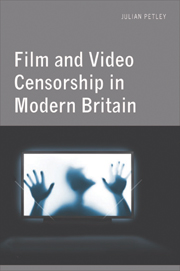Book contents
- Frontmatter
- Contents
- Acknowledgements
- Dedication
- Introduction
- Part I Censorious Rigmarole and Legalistic Overkill
- Part II After the Deluge
- Part III Nineties Nightmares
- Part IV New Millennium, New Beginning?
- 12 ‘The Way Things Are Now’: An Interview with Robin Duval
- 13 The Limits of the Possible
- 14 Full Circle
- Appendix: The DPP List of ‘Video Nasties’
- Bibliography
- Index
13 - The Limits of the Possible
from Part IV - New Millennium, New Beginning?
Published online by Cambridge University Press: 05 August 2013
- Frontmatter
- Contents
- Acknowledgements
- Dedication
- Introduction
- Part I Censorious Rigmarole and Legalistic Overkill
- Part II After the Deluge
- Part III Nineties Nightmares
- Part IV New Millennium, New Beginning?
- 12 ‘The Way Things Are Now’: An Interview with Robin Duval
- 13 The Limits of the Possible
- 14 Full Circle
- Appendix: The DPP List of ‘Video Nasties’
- Bibliography
- Index
Summary
On 18 June 2001 Carl Daft of the distributor Blue Underground angrily declaimed that ‘the right to free speech in the United Kingdom died today, and for that I have to say that I am ashamed to be British’, whilst Mark Kermode in the Independent (21 June) bemoaned a decision that ‘leaves British horror fans once again in the wilderness’. The cause of such fury and bemusement was the decision of the Video Appeals Committee (VAC) not only to uphold the British Board of Film Classification's decision to insist on sixteen seconds of cuts in the video of Wes Craven's debut feature Last House on the Left before giving it an ‘18’ certificate but also effectively to criticise the Board for being too lenient to the film in the first place.
Last House on the Left is loosely based on the Ingmar Bergman film Jungfrukällen (The Virgin Spring). Craven's film tells the story of two country girls who, on a visit to New York, are abducted by a gang of drug peddlers, and, in the course of a journey towards the Canadian border, raped, tortured and finally killed. When their car subsequently breaks down in the country, the gang members ask for help at a nearby house, which turns out to be the home of the parents of one of their victims. Once they have discovered the truth of the situation, the parents wreak a terrible revenge.
- Type
- Chapter
- Information
- Film and Video Censorship in Modern Britain , pp. 173 - 196Publisher: Edinburgh University PressPrint publication year: 2011

